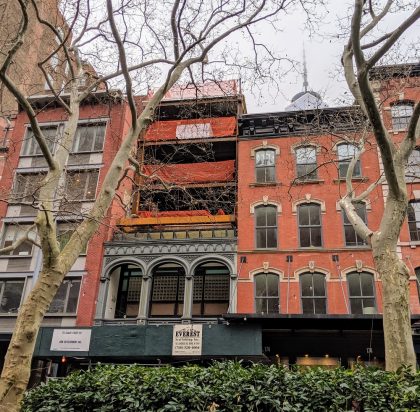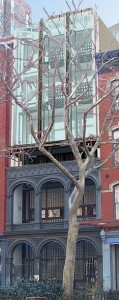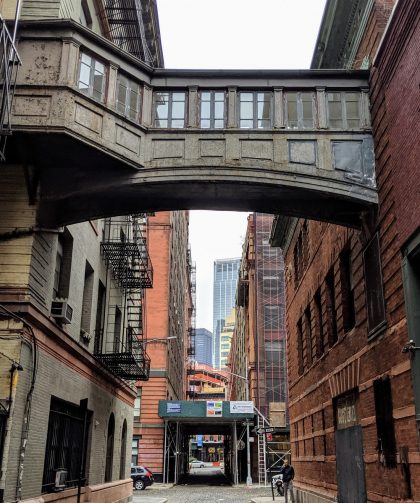Adding four floors to 172 Duane’s fanciful facade
This just caught my eye coming down Staple Street — somehow missed it the hundred or so times I have walked under the sidewalk bridge on Duane. Plans that have been in the works for nearly a decade for the building with the fanciful cast-iron columns are now in play, having been approved after several re-dos by the Landmarks Commission in 2017. (The building’s history is featured here in Tom Miller’s post.) (It was also the longtime HQ of hip-hop impresario Damon Dash, who had a lease there until 2011.)
Permits on file with the city say the owner is adding a four-story addition for a two-family dwelling to add to the existing two-story commercial structure below. There will also be a residential exit on the front of the building. The end result will be a six-story, 3200-square-foot house, according to records (though it looks bigger than that to me). Looks like the building was sold in 2014 for $10 million, so these plans may be a vestigial remains from the original expansion rejected by Landmarks, which called for an 8000-square-foot addition by the Italian architect who modernized the building in the ’80s — Vincenzo Polsinelli.
Though the 1871 building had a variety of merchants as tenants over the decades, its last iteration was as a classic Tribeca butter-and-egg commission house — Johnstone & Coughlan. But by the time the 1980s rolled around, the facade was battered and nearly ruined. The landmark district was not yet in place, so the owner sent the facade out to Utah to be restored and set it in place in front of the modern box behind it. From Miller’s post:
“The new owner wanted a new, modern space and commissioned world-renowned architect Vincenzo Polsinelli to create it. At the time there were no landmark restrictions on the buildings and restoration or demolition was purely up to the discretion of the owners and designers.
Polsinelli later said that while the façade was in a “sinful state of preservation,” he recognized its historic and architectural importance. The façade was dismantled and sent to Utah for restoration. In the meantime, the 19th century loft was replaced by a sleek glass block-fronted building with no hint of history.
In 1991, the impeccably restored façade was set in place, six feet in front of the new building. Called by the Historic Districts Council “nicely designed and detailed to make a small building impressive,” it now served as a gateway. Polsinelli and the building’s owner received wide-spread congratulations for saving the cast-iron front and incorporating it into the new design. Yet preservationists held back a bit. Calling the practice ‘facadism’ — a term never meant to intimate applause — they mourned the loss of the original structure.”
UPDATE 2/25/20: I happened to hear from Polsinelli, who is American and has practiced in the U.S. since 1980. He was last involved in this project in 2009. After he got the original Landmarks approval, the owner hired another architect. He added: “The design (do not know who did it) is really lacking sensibility for this rich neighborhood. Very surprised Landmarks approved the change!”
















